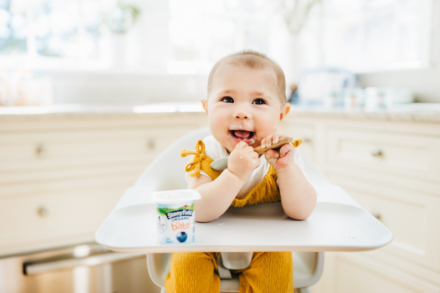All About Baby-Led Weaning
September 10, 2015
webmaster@push10.com

You give your baby pieces of soft, “graspable” food and allow her to eat at her own pace and in her own way.
A big change is the growing trend of skipping spoon-fed purees altogether and letting baby feed herself. The approach is called Baby-Led Weaning (BLW) and it’s started at six months, when babies typically have the motor skills to grab food and bring it to their mouths. How it works: You give your baby pieces of soft, “graspable” food (typically table foods your family is already having at mealtime, like wedges of peeled sweet potato, well-cooked carrot, steamed broccoli floret, or very ripe fruit) and allow her to eat at her own pace and in her own way.
Fans of baby-led weaning say that since babies are exposed to more textures early on and start eating regular table food sooner than babies fed only purees, they may be more accepting of different kinds of foods and grow into less picky eaters. Advocates also say that since babies are in control of how much they eat (instead of having a grown-up put spoonfuls of food into their mouths), they may become better at regulating how much they eat—a skill that could help with weight control throughout life.
Some of the downsides of baby-led weaning: It’s messy, no way around it. Your baby is learning how to chew food first–instead of learning how to swallow purees –so a lot of food will come back right out of his mouth (or drop out of his hands). With baby-led weaning, babies may gag a bit while eating too, which is scary for parents but a built-in safety mechanism and a part of learning how to chew and swallow. Also, in addition to choking concerns in general, baby-led weaning may not be right for all babies, like those with motor delays. Babies born prematurely may not be ready for self-feeding at six months either. It’s smart to talk to your pediatrician about whether baby-led weaning could work for you and your child.
So what about foods like yogurt that babies can’t exactly grab and hold? You can still incorporate them into baby-led weaning. Here’s how:
- Put a dollop of yogurt on your baby’s high chair tray. (Pediatricians approve yogurt for babies 6 months and up.) Let him eat it with his hands or a soft spoon, or give him other foods like banana for dipping.
- Load a soft spoon with yogurt and let baby feed himself.
- Spread yogurt on pieces of fruit or toast for self-feeding.
Also, keep in mind that you can do a combination of traditional feeding and baby-led weaning by offering both purees and pieces of soft food when you start solids. What’s most important is that you (and your baby!) feel comfortable with whatever approach you decide to take.
Disclaimer: The views and opinions expressed in this post are solely those of the author and do not necessarily reflect the opinions and views of Stonyfield. The content provided, and in any linked materials, are not intended and should not be construed as medical advice. If you have any questions about health or nutrition, we always think it’s best to consult with your doctor or healthcare practitioner.
